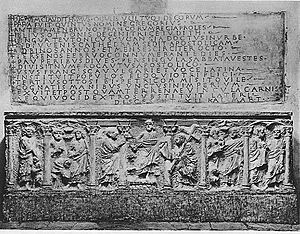Pope Gregory V facts for kids
Quick facts for kids Pope Gregory V |
|
|---|---|
| Bishop of Rome | |
| Church | Catholic Church |
| Papacy began | 3 May 996 |
| Papacy ended | 18 February 999 |
| Predecessor | John XV |
| Successor | Sylvester II |
| Personal details | |
| Birth name | Bruno of Carinthia |
| Born | c. 972 Stainach, Duchy of Carinthia, Holy Roman Empire |
| Died | 18 February 999 (aged c. 27) Rome, Papal States |
| Other Popes named Gregory | |
Pope Gregory V (Latin: Gregorius V; c. 972 – 18 February 999), born Bruno of Carinthia, was the bishop of Rome and ruler of the Papal States from 3 May 996 to his death. A member of the Salian dynasty, he was made pope by his cousin, Emperor Otto III.
Contents
Family
Bruno was a son of Otto I, Duke of Carinthia, a member of the Salian dynasty who was a grandson of Holy Roman Emperor Otto I.
Papal election
Bruno, was the chaplain of his cousin, Emperor Otto III, who presented him as a candidate and arranged his election. Bruno, was elected and succeeded John XV as pope, taking the name Gregory V. He is often counted as the first German pope (or the second if Boniface II, an Ostrogoth, is counted). Following Otto's return to Germany, Gregory was forced to flee Rome, after the election of antipope John XVI, whom Crescentius II and the nobles of Rome had chosen against the will of Otto III.
Policies
Politically, Gregory acted consistently as the Emperor's representative in Rome and granted many exceptional privileges to monasteries within the Holy Roman Empire. One of his first acts was to crown Otto III emperor on 21 May 996. Together, they held a synod a few days after the coronation in which Arnulf, Archbishop of Reims, was ordered to be restored to his See of Reims, and Gerbert of Aurillac, was condemned as an intruder. King Robert II of France, who had been insisting on his right to appoint bishops, was ultimately forced to back down, and also to put aside his wife, Bertha of Burgundy, by the rigorous enforcement of a sentence of excommunication on the kingdom.
Until the conclusion of the council of Pavia in 997, John XVI and Crescentius were in possession of Rome. The revolt of Crescentius II was decisively suppressed by the Otto III, who marched upon Rome. John XVI fled, and Crescentius shut himself up in the Castel Sant'Angelo. The Emperor's troops pursued the antipope and captured him. When the much respected St. Nilus of Rossano castigated both the Emperor and Pope for their cruelty, John XVI was sent to the monastery of Fulda in Germany, where he lived until c. 1001. The Castel Sant'Angelo was besieged, and when it was taken in 998, Crescentius was executed.
Death
Gregory V died suddenly, not without suspicion of foul play, on 18 February 999. He is buried in St. Peter's Basilica near Pope Pelagius I. His successor was Gerbert, who took the name Sylvester II.
See also
 In Spanish: Gregorio V para niños
In Spanish: Gregorio V para niños


